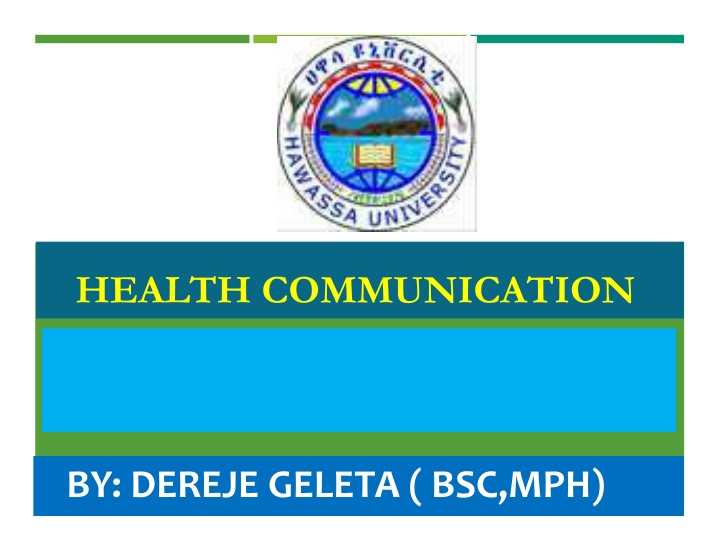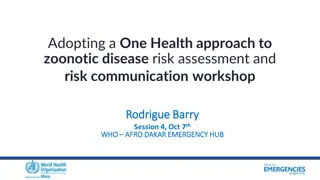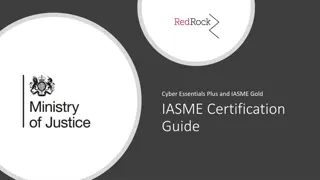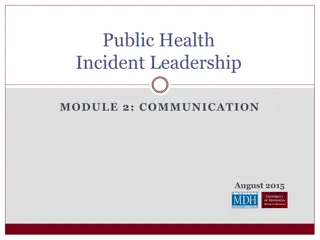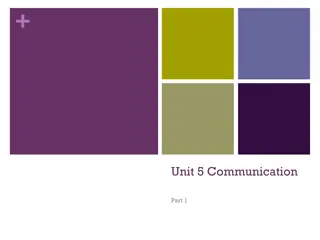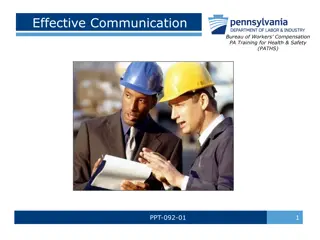Health Communication Essentials
Communication in health settings is vital for creating behavioral change and promoting public health. This module by Dereje Geleta, BSC, MPH, explores the components, appeals, and barriers of effective communication. Learn about the key characteristics of health communication, including being audience-centered, research-based, and aimed at social change. Understand the roles of sender, message, channel, receiver, and feedback in the communication process.
Download Presentation

Please find below an Image/Link to download the presentation.
The content on the website is provided AS IS for your information and personal use only. It may not be sold, licensed, or shared on other websites without obtaining consent from the author.If you encounter any issues during the download, it is possible that the publisher has removed the file from their server.
You are allowed to download the files provided on this website for personal or commercial use, subject to the condition that they are used lawfully. All files are the property of their respective owners.
The content on the website is provided AS IS for your information and personal use only. It may not be sold, licensed, or shared on other websites without obtaining consent from the author.
E N D
Presentation Transcript
HEALTH COMMUNICATION BY: DEREJE GELETA ( BSC,MPH)
LEARNING OBJECTIVE Upon successful the completion of this Module, the student will able to: Describe communication List the components of communication List Appeals of communication List barriers to effective communication BY: DEREJE G (BSC,MPH), HU 2/19/2025 2
INTRODUCTION Communication is the process by which two or more people exchange ideas, facts, feelings or impressions in ways that each gains a common or mutual understanding of the meaning and the use of the use of the message. Evert M. Rogers (1993), defined communication as the process by which an idea is transferred from a source to a receiver with intent to change his/her behavior. BY: DEREJE G (BSC,MPH), HU 2/19/2025 3
RELEVANCE TO HEALTH To mobilize To implement To coordinate with different agencies. The ultimate goal of all Health communication is to create behavioral change. mobilize the community, implement HE & HP programs create behavioral change. BY: DEREJE G (BSC,MPH), HU 2/19/2025 4
KEY CHARACTERISTICS OF HEALTH COMMUNICATION Audience-centered Research-based Multidisciplinary Strategic Cost-effective Aimed at behavioral or social change (BCC/SBCC) BY: DEREJE G (BSC,MPH), HU 5 2/19/2025
COMPONENTS OF COMMUNICATION Sender/source Message Channel Receiver Feedback Sender/source Message Channel Receiver Feedback BY: DEREJE G (BSC,MPH), HU 6 2/19/2025
SOURCE The sender is the originator of the messages. The source can be from an individual or groups, an institution or organization. BY: DEREJE G (BSC,MPH), HU 2/19/2025 7
RECEIVER/AUDIENCE Is the person or the group for whom the communication is intended or the person who receive the message. BY: DEREJE G (BSC,MPH), HU 2/19/2025 8
MESSAGE Message is a piece of information, ideas, facts, opinion, feeling, attitude or a course of action that passed from the sender to the receiver the sender to the receiver. . It is the subject matter of communication. Something that is considered important for the audience to know or do BY: DEREJE G (BSC,MPH), HU 2/19/2025 9
TYPES OF APPEALS IN HEALTH COMMUNICATIONS A. Fear arousal appeal A. Fear arousal appeal The message is conveyed to frighten people into action by emphasizing the serious outcome from not taking action. Symbols such as dying persons, coffins, grave stones, skulls may be used. It is good for a person with little or no school. BY: DEREJE G (BSC,MPH), HU 2/19/2025 10
CONT Evidence suggests that mild fear can arouse interest, create concern & lead to change. However too much fear can lead to people denying & rejecting Too much fear is not appropriate for two reasons 1 1st st : : It can lead to denying & rejecting the message and results in laughter & failure to take action . 2 2nd denying rejecting the message. for two reasons; nd : : It also involves ethical issues. BY: DEREJE G (BSC,MPH), HU 2/19/2025 11
B. HUMOUR The message is conveyed in a funny way such as cartoon. Humour very good way of attracting interest & attention. It can also serve as useful role to lighten tension lighten the tension when dealing is serious subjects. BY: DEREJE G (BSC,MPH), HU 2/19/2025 12
CONT Enjoyment & entertainment can result in highly effective remembering and learning. However, humor does not always lead to changes in beliefs & attitudes. Humor also very subjective What one person finds funny another person may not. BY: DEREJE G (BSC,MPH), HU 2/19/2025 13
C. LOGICAL/FACTUAL The message is conveyed to convince people by giving facts, figures and information It carries weight with a person of high educational level. Information on its own is usually not enough to change behaviors BY: DEREJE G (BSC,MPH), HU 2/19/2025 14
D. EMOTIONAL APPEAL The message is conveying to convince people by arousing emotions, images & feelings rather than giving facts & figures e.g. by showing smiling babies, wealthy families with latrine, etc., and associating with FP education. A Person with less education will often be more convinced by simple emotional appeals from people they trust. BY: DEREJE G (BSC,MPH), HU 2/19/2025 15
E. ONE SIDED MESSAGE Only presents the advantages of taking action & does not mention any possible disadvantages. E.g. educating the mothers only about benefits of oral contraceptive pill. F. Two sided message Presents both the advantages & disadvantages (pros & cons ) of taking action. BY: DEREJE G (BSC,MPH), HU 2/19/2025 16
G. POSITIVE APPEAL Communications that ask people to do something, e.g. breast feed your child, use a latrine. H. Negative Appeal Communications that ask people not to do something, e.g. do not bottle feed your child, do not defecate in the bush. H. Negative Appeal BY: DEREJE G (BSC,MPH), HU 2/19/2025 17
CHANNEL A channel is the physical bridge or the media by which the message travels from a source to a receiver. The commonest types of channel are audio, visual, or combined audio-visual & printed materials The channel is essential. The medium be it TV, newspaper, or a meeting dictates who receives the message. BY: DEREJE G (BSC,MPH), HU 2/19/2025 18
FEEDBACK FEEDBACK Feedback Is the mechanism of assessing what has happened on the receivers after the communication has occurred. A communication is said to have feedback when the receiver of the message gives his/her responses to the sender of the message. BY: DEREJE G (BSC,MPH), HU 2/19/2025 19
MODELS OF COMMUNICATION 1.One way model Sender Linear type of communication. No feedback. No opportunity to clear up misunderstanding Meaning is controlled by a receiver what message how much communicated Sender message message Channel Channel Receiver Receiver. . BY: DEREJE G (BSC,MPH), HU 20 2/19/2025
CONT No input from the receiver Motivation of the sender may be personal gain or public good Quick if the message is simple communication e.g. date & time of meeting may be less effective simple and needs quicker quicker BY: DEREJE G (BSC,MPH), HU 21 2/19/2025
2. TWO-WAY COMMUNICATION Feedback Channel Receiver Message Sender BY: DEREJE G (BSC,MPH), HU 22 2/19/2025
CONT. Advantages Suitable for more complex messages Feedback is added Allows the sender to find out how much the message is received - can be monitored Sender can affect the quality and quantity of the feedback through the type of question chosen and the way it is asked. Advantages BY: DEREJE G (BSC,MPH), HU 23 2/19/2025
METHODS OF COMMUNICATION There are two main groups of methods; Face-to-face ( interpersonal ) Mass media. BY: DEREJE G (BSC,MPH), HU 24 2/19/2025
INTERPERSONAL METHODS Forms of communication involving direct interaction between the source & receiver. In most instances the decisive criterion for personal communication is. Communication at the same time & Communication at the same place. BY: DEREJE G (BSC,MPH), HU 25 2/19/2025
CONT 1. Dynamic or bi-directional 2. Feed back 3. Multisensory (channel) 4. Useful in all stages of adoption of innovation 5. useful when the topic is taboo or sensitive. 6. Can fit to local needs 7. Can be highly selective BY: DEREJE G (BSC,MPH), HU 26 2/19/2025
LIMITATIONS Easily distorted as we mostly rely on word-of-mouth. Often needs multi-lingual Needs personal status/ credibility Needs professional knowledge & preparation BY: DEREJE G (BSC,MPH), HU 27 2/19/2025
MASS COMMUNICATION Is a means of transmitting messages, on an electronic or print media, for a large segment of a population. BY: DEREJE G (BSC,MPH), HU 28 2/19/2025
ADVANTAGES 1. They can reach many people quickly. 2. They are accurate and believable e.g. article on a newspaper, or voice of highly respected person. 3. They can provide continuing reminders and reinforcement. 4. Useful to communicate new ideas to early adopters (opinion leaders). 29 2/19/2025 BY: DEREJE G (BSC,MPH), HU
LIMITATIONS 1. One sided/poorly organized 2. Does not differentiate the target 3. Only provides non-specific information BY: DEREJE G (BSC,MPH), HU 30 2/19/2025
BARRIERS TO EFFECTIVE COMMUNICATIONS 1. Physical Difficulties in hearing, seeing In appropriate physical facilities BY: DEREJE G (BSC,MPH), HU 31 2/19/2025
CONT 2. Intellectual The natural ability, home background, schooling affects the perception of the receiver for what he sees & hears. The ability of the facilitator/ education/ instructor. BY: DEREJE G (BSC,MPH), HU 32 2/19/2025
CONT. 3. Emotional Readiness, willingness or eagerness of the receiver Emotional status of the educator BY: DEREJE G (BSC,MPH), HU 33 2/19/2025
CONT. 4. Environmental Noise, invisibility, congestion BY: DEREJE G (BSC,MPH), HU 34 2/19/2025
CONT 5. Cultural Customs, beliefs, religion, attitudes, economic and social class differences, language variation. 6. Status of the source 7. Inconsistencies between verbal & non- verbal communication BY: DEREJE G (BSC,MPH), HU 35 2/19/2025
THE END THANK YOU !! BY: DEREJE G (BSC,MPH), HU 2/19/2025 36
